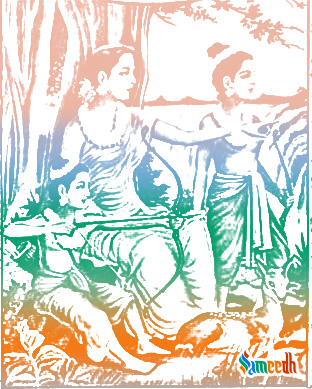Sita is a well-known Hindu Goddess who, in the Hindu epic Ramayan, is the silent symbol of strength. Sita is truly the First Lady of the Ramayan. As a wife, daughter, and mother, she exemplifies commitment. Sita is not just a queen or a wife — she is Shakti, divine strength in human form.

Who is Sita?
-
Name: Sita (सीता) — meaning “furrow” or “ploughed land” — because King Janaka found her while ploughing the fields.
-
Other Names: Janaki (daughter of Janaka), Vaidehi (princess of Videha), Bhoomija (daughter of Earth), Maithili (princess of Mithila).
-
Father: King Janaka of Mithila.
-
Mother: Queen Sunaina (sometimes her mother is symbolic as Mother Earth herself).
Sita was a poetic expression that meant fertility and the various benefits that came with settled agriculture. The Ramayan’s Sita may have been named after a more ancient Vedic deity named Sita, who is referenced in the Rigveda as an earth goddess who blesses the land with plentiful crops. She was one of the deities linked with fertility throughout the Vedic period.
Sita is a Hindu deity who appears in the Hindu epic Ramayan as the female heroine. She is the partner of Ram, the god Vishnu’s avatar, and is thought to be a reincarnation of Vishnu’s wife Lakshmi. In Rama-centric Hindu religions, she is also the most powerful goddess. Sita is revered for her self-sacrifice, bravery, and purity. Sita Navami (also called Janaki Navami) is a Hindu festival that celebrates the birth of Goddess Sita, an incarnation of Goddess Lakshmi. It falls on the ninth day (Navami) of Shukla Paksha (waxing moon fortnight) in the month of Vaishakha (around April-May).
Life Story
-
Marriage to Ram: Sita is married to Ram after a grand Swayamvar, where Ram strings and breaks the mighty bow of Shiv (Pinaka).
-
Exile: She accompanies Ram during his 14-year exile into the forest, choosing love and duty over royal comfort.
-
Abduction by Ravan: Sita is kidnapped by Ravan and held captive in Lanka, where she remains steadfast and pure, praying only for Ram’s rescue.
-
Rescue and Agni Pariksha: After Ram defeats Ravan, Sita undergoes an Agni Pariksha (test by fire) to prove her purity, emerging unharmed and even more radiant.
-
Exile and Birth of Sons: Later, due to public doubts, Sita is exiled while pregnant. She finds refuge at Sage Valmiki’s ashram and gives birth to twin sons — Lava and Kush.
-
Return to Mother Earth: After reuniting with Ram briefly, Sita, tired of worldly injustice, asks her Mother Earth to take her back — and she is swallowed by the ground, returning to her divine origins.
Sita is raised as King Janak of Videha’s adopted daughter. In a swayamvar, Sita selects Ram, the prince of Ayodhya, as her husband while she is young. She returns to her husband’s realm after the swayamvar, but subsequently chooses to accompany her husband in exile with her brother-in-law Lakshman. The trio settles in the Dandaka forest while in exile when she is kidnapped by Ravan, Lanka’s Rakshas ruler. She is held captive in Ashoka Vatika’s garden in Lanka until she is freed by Ram, who kills her captor. After the fight, Ram requires Sita to go through Agni Pariksha (a fire ordeal) to prove her purity before being accepted by Ram.
Ram and Sita return to Ayodhya after proving their purity, and they are crowned king and queen. Years later, when Sita is expecting twins, a man questions their legitimacy. In trying to maintain order, Ram sends her into the forest near the ashram of the sage Valmiki to establish her innocence and protect his and the kingdom’s dignity. Years later, Ram after reuniting her two boys Kusha and Lava with their father Ram, Sita returns to the womb of her mother, the Earth, for escape from a cruel world and as a testament to her purity.

Sita with her two sons, Lava and Kusha; Image Source: Mani Karthik
Sita’s Symbolism:
-
Purity: She is the symbol of chastity and virtue.
-
Strength: Her life shows immense patience and inner strength.
-
Devotion: She epitomizes loyalty to dharma (righteousness) and family.
-
Dignity: Sita shows that dignity can be maintained even in suffering.
Sita makes the point that justifying her purity yet again is humiliating not only to her but to the entire female society. Devi Sita is depicted as a symbol of bravery, knowledge, and endurance in this scene. Sita is a well-known Hindu Goddess who, in the Hindu epic Ramayan, is the silent symbol of strength. As a wife, daughter, and mother, she exemplifies commitment. She persevered through a life of adversity and adversity with bravery and courage. She exudes a strong feeling of personality. Sita’s life is a story of sacrifice, endurance, and strength, and is an inspiration to many. She stood up for herself and her dignity so many years ago, and left a mark for all the women till date to follow.
Why is she called Maa Sita?
-
Mother of Lava and Kusha: Sita literally becomes a mother to her twin sons, but symbolically she is seen as the mother of all those who live by dharm (righteousness).
-
Protector of Virtue: In every hardship — in exile, in captivity, in exile again — she remains unshaken. Her story teaches that true strength is quiet, patient, and inner.
-
Avatar of Goddess Lakshmi: Sita is considered an incarnation of Lakshmi, the goddess of fortune and well-being. As Lakshmi supports Lord Vishnu, Sita supports Lord Ram’s mission on Earth.
-
Mother Earth’s Daughter: Born from the Earth (Bhoomi Devi), Sita is connected to nature, patience, and nurturing — qualities of a true mother.